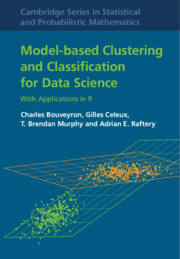Crossref Citations
This Book has been
cited by the following publications. This list is generated based on data provided by Crossref.
Harada, Daisuke
Asanoi, Hidetsugu
Noto, Takahisa
and
Takagawa, Junya
2020.
Different Pathophysiology and Outcomes of Heart Failure With Preserved Ejection Fraction Stratified by K-Means Clustering.
Frontiers in Cardiovascular Medicine,
Vol. 7,
Issue. ,
Pradana, I Gusti Made Teddy
and
Djatna, Taufik
2020.
A Design of Traceability System in Coffee Supply Chain based on Hierarchical Cluster Analysis Approach.
p.
1.
Lazic, Stanley E
and
Williams, Dominic P
2020.
Improving drug safety predictions by reducing poor analytical practices.
Toxicology Research and Application,
Vol. 4,
Issue. ,
Zagalo, Kevin
Cucu-Grosjean, Liliana
and
Bar-Hen, Avner
2020.
Identification of execution modes for real-time systems using cluster analysis.
p.
1.
Véstias, Mário P.
2020.
Smart Systems Design, Applications, and Challenges.
p.
23.
Zhang, Wanli
and
Di, Yanming
2020.
Model-Based Clustering with Measurement or Estimation Errors.
Genes,
Vol. 11,
Issue. 2,
p.
185.
Jiang, Liupeng
Jiang, He
and
Wang, Harry Haoxiang
2020.
Soft computing model using cluster-PCA in port model for throughput forecasting.
Soft Computing,
Vol. 24,
Issue. 18,
p.
14167.
Giordani, Paolo
Ferraro, Maria Brigida
and
Martella, Francesca
2020.
An Introduction to Clustering with R.
Vol. 1,
Issue. ,
p.
291.
Lian, Qiuyu
Xin, Hongyi
Ma, Jianzhu
Konnikova, Liza
Chen, Wei
Gu, Jin
and
Chen, Kong
2020.
Artificial-cell-type aware cell-type classification in CITE-seq.
Bioinformatics,
Vol. 36,
Issue. Supplement_1,
p.
i542.
Waggoner, Philip D.
2020.
Unsupervised Machine Learning for Clustering in Political and Social Research.
Kalmin, O. V.
and
Kalmin, O. O.
2020.
Mathematical Modeling of Morphometric Parameters of Thyroid Gland Structure.
p.
1.
Giordani, Paolo
Ferraro, Maria Brigida
and
Martella, Francesca
2020.
An Introduction to Clustering with R.
Vol. 1,
Issue. ,
p.
215.
Schmutz, Amandine
Jacques, Julien
Bouveyron, Charles
Chèze, Laurence
and
Martin, Pauline
2020.
Clustering multivariate functional data in group-specific functional subspaces.
Computational Statistics,
Vol. 35,
Issue. 3,
p.
1101.
Araújo, Ramon C. F.
de Oliveira, Rodrigo M. S.
Brasil, Fernando S.
and
Barros, Fabrício J. B.
2021.
Novel Features and PRPD Image Denoising Method for Improved Single-Source Partial Discharges Classification in On-Line Hydro-Generators.
Energies,
Vol. 14,
Issue. 11,
p.
3267.
Lin, Lin
and
Hejblum, Boris P
2021.
Bayesian mixture models for cytometry data analysis.
WIREs Computational Statistics,
Vol. 13,
Issue. 4,
Fraix-Burnet, D.
Bouveyron, C.
and
Moultaka, J.
2021.
Unsupervised classification of SDSS galaxy spectra.
Astronomy & Astrophysics,
Vol. 649,
Issue. ,
p.
A53.
王, 琳
2021.
Time Series Clustering with MS-GARCH Mixtures.
Statistics and Application,
Vol. 10,
Issue. 06,
p.
1071.
Jouvin, Nicolas
Bouveyron, Charles
and
Latouche, Pierre
2021.
A Bayesian Fisher-EM algorithm for discriminative Gaussian subspace clustering.
Statistics and Computing,
Vol. 31,
Issue. 4,
Hu, Zhengbing
and
Tyshchenko, Oleksii K.
2021.
Advances in Computer Science for Engineering and Education III.
Vol. 1247,
Issue. ,
p.
419.
Amine Atoui, M.
and
Cocquempot, Vincent
2021.
Open set diagnosis: high-dimensional clustering.
p.
1046.



